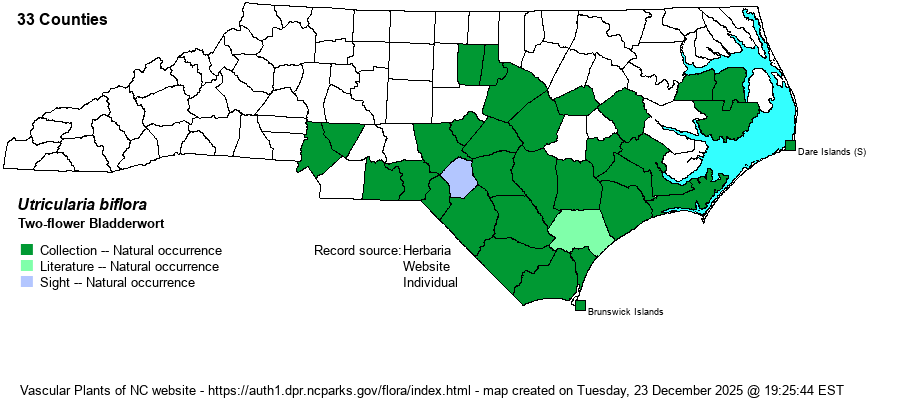| Section 6 » Family Lentibulariaceae |
Show/Hide Synonym
| taxonName | relationship | relatedTaxonName | relatedTaxonRefText | relComments |
|---|
|
|
|
|
|
|
|
| Utricularia biflora | = | Utricularia pumila | Small (1933, 1938) | misapplied | | Utricularia biflora | = | Utricularia pumila | | misapplied | | Utricularia biflora | < | Utricularia gibba | Flora of North America (1993b, 1997, 2000, 2002a, 2002b, 2003a, 2004b, 2005, 2006a, 2006b, 2006c, 2007a, 2009, 2010) | | | Utricularia biflora | < | Utricularia gibba | | | | Utricularia biflora | < | Utricularia gibba | | | | Utricularia biflora | < | Utricularia gibba | Wunderlin & Hansen Flora of Florida (3) | | | Utricularia biflora | < | Utricularia gibba | Fischer et al. in Kadereit (2004). Key based in part on Z and GW. | | | Utricularia biflora | < | Utricularia gibba | Fischer et al. in Kadereit (2004). Key based in part on Z and GW. | | | Source: Weakley's Flora |
|
| Author | Lamarck | |
| Distribution | Present over most of the southern 60% of the Coastal Plain, and sparingly west into the southern Piedmont (to Cabarrus and Mecklenburg counties). No records yet for north of Albemarle Sound. Specimens from Cherokee, Rowan, Forsyth, and Davidson counties, originally determined as U. biflora, were identified as U. gibba in 2022 by B.A. Sorrie, due to short blunt spurs and short flowering stems.
This is an Eastern species ranging from MA south to FL, and then west to TX and OK. It is found mostly in the Atlantic and Gulf Coastal Plains. The BONAP map also includes Utricularia gibba, which ranges much farther north and west than does U. biflora. | |
| Abundance | Infrequent to fairly common in the southern half of the Coastal Plain, but rare along the northern part of the range. Very rare in the Piedmont and Mountain portions of the range. | |
| Habitat | This species grows essentially only in still, but shallow, fresh water, such as in ponds (mostly along the margins), pools, and wet ditches. |
| Phenology | It has a wide blooming period, from June into October; it fruits shortly after flowering. | |
| Identification | This species and U. gibba are extremely similar, and are more often lumped into one species than split out. U. biflora grows in "tangled mats" (RAB 1968), with slender (threadlike) leaves that are forked twice; these are hard to spot as they are usually within the water. There are very small "traps" along the leaf segments. Most noticeable is the flowering scape, which is very slender and about 3-4 inches tall, with typically two flowers. The flowers are bright yellow (as are most bladderworts) and about 2/3-inch across. This species has the lip of the lower petal 8-10 mm (nearly 1/3-inch) long, and the spur behind the flower is 5-9 mm long. U. gibba is similar but the flower is slightly smaller, with the lip being 5-6 mm long, and the spur is only about 4 mm long. Weakley (2024) indicates that the lip of U. biflora about equals or is a bit shorter than the spur, whereas in U. gibba the spur is clearly shorter than the lip. U. gibba leaves are usually forked just once, but that would be hard to see without pulling plants out of the water and then untangling the leaves! Note -- two other species are very similar, but have two types of leaves, one with numerous traps along the leaf segments, and the other with some leaf segments essentially without traps; these are U. floridana and U. striata (formerly naned as U. fibrosa). Obviously, a biologist needs to pull a few plants out of the water and examine the leaf segments closely. | |
| Taxonomic Comments | This species and U. gibba have often been lumped into a single species. NatureServe and the Flora of North America website have it included within U. gibba, whereas Weakley (2024) has them separate, as did RAB (1968) over 50 years ago. Even Weakley (2024) does admit that "This species may not be distinct from U. gibba".
| |
| Other Common Name(s) | Longspur Creeping Bladderwort | |
| State Rank | S4 | |
| Global Rank | GNA | |
| State Status | | |
| US Status | | |
| USACE-agcp | | |
| USACE-emp | | |

